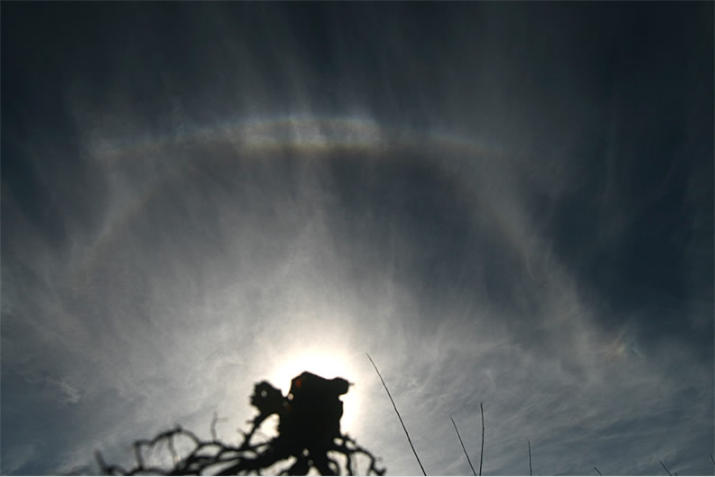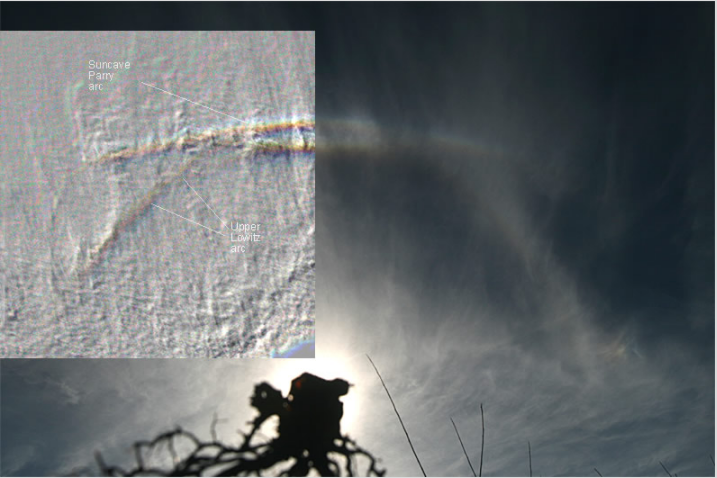Upper Lowitz arc - San Francisco
Upper Lowitz Arc - San Francisco: A Rare Atmospheric Phenomenon
The Upper Lowitz arc is a captivating atmospheric optics phenomenon that can occasionally be observed in San Francisco. This unique optical effect is characterized by a bright 10 o'clock 22° halo region and potentially extends above it. It was beautifully captured on November 17th, 2006, by photographer Mila Zinkova, who graciously shared her image.
The Upper Lowitz Arc: An Enigmatic Halo
The Upper Lowitz arc is one of the lesser-known halos that can grace the skies above San Francisco. Halos are formed when sunlight interacts with ice crystals in the atmosphere, creating stunning displays of light. While the 22° halo is more commonly observed, the Upper Lowitz arc adds an extra touch of enchantment to the atmospheric spectacle.
Unveiling the Science Behind the Upper Lowitz Arc
To understand the formation of the Upper Lowitz arc, we turn to the research conducted by Riikonen et.al., who proposed a fascinating theory. According to their findings, this particular arc could be produced by column crystals that rock about a Lowitz axis perpendicular to the long 'c' axis. These crystal movements give rise to the distinct appearance of the Upper Lowitz arc in the sky.
Exploring the Unique Characteristics
The Upper Lowitz arc exhibits several distinct features that set it apart from other atmospheric phenomena. Here are some noteworthy characteristics:
- Location: The Upper Lowitz arc appears at the 10 o'clock position relative to the observer's line of sight, within the larger 22° halo region.
- Brightness: This arc tends to be brighter than the surrounding halo, making it more conspicuous and captivating.
- Possible Extension: In some cases, the Upper Lowitz arc may extend beyond the 22° halo, creating an even more extraordinary spectacle.
Observing the Upper Lowitz Arc
Spotting the Upper Lowitz arc in San Francisco can be a rare and exhilarating experience. Here are a few tips to enhance your chances of witnessing this atmospheric wonder:
- Timing: The arc is most likely to appear when the sun is relatively low in the sky, such as during sunrise or sunset. Keep an eye out for it during these times.
- Weather Conditions: Clear or partly cloudy skies provide the best conditions for observing the Upper Lowitz arc. Check the weather forecast and plan your observation accordingly.
- Location: Find an open area with an unobstructed view of the sky. Elevated locations, such as hilltops or rooftops, can offer a better vantage point.
Joining the Atmospheric Optics Community
If you're captivated by atmospheric optics phenomena like the Upper Lowitz arc, consider joining the vibrant community of enthusiasts and experts. Engaging with fellow sky-watchers can provide valuable insights, tips, and even opportunities to collaborate on research or photography projects.
- Online Forums: Participate in online forums dedicated to atmospheric optics, where you can share your observations, ask questions, and learn from experienced individuals.
- Local Groups: Look for local astronomy or atmospheric optics groups in your area. These communities often organize events, workshops, and stargazing sessions where you can deepen your knowledge and meet like-minded individuals.
Capturing the Upper Lowitz Arc: Photography Tips
Photographing the Upper Lowitz arc can be a rewarding challenge. Here are a few tips to help you capture its beauty:
- Equipment: Use a camera with manual settings to have more control over exposure and focus.
- Lens Choice: Wide-angle lenses are ideal for capturing atmospheric phenomena as they allow you to include more of the sky in your frame.
- Exposure Settings: Experiment with different exposure settings to find the right balance between capturing the arc's details and avoiding overexposure.
- Composition: Consider incorporating interesting foreground elements to create a visually compelling composition.
The Wonder of Atmospheric Optics
The Upper Lowitz arc in San Francisco is just one of the many awe-inspiring atmospheric optics phenomena that grace our skies. From halos and sundogs to rainbows and iridescence, these captivating displays remind us of the immense beauty and complexity of the natural world. So, keep your eyes to the sky and embrace the wonders that unfold above us.


Upper Lowitz arc, San Francisco imaged on 17th November 2006 by Mila Zinkova. ©Mila Zinkova, shown with permission.
The arc is apparent as the bright 10 o'clock 22° halo region and possibly above.
Mouse over for an enhanced view.
Arcs like this could be produced by column crystals rocking about a Lowitz axis perpendicular to the long 'c' axis as suggested by Riikonen et.al.
Note: this article has been automatically converted from the old site and may not appear as intended. You can find the original article here.
Reference Atmospheric Optics
If you use any of the definitions, information, or data presented on Atmospheric Optics, please copy the link or reference below to properly credit us as the reference source. Thank you!
-
<a href="https://atoptics.co.uk/blog/upper-lowitz-arc-san-francisco/">Upper Lowitz arc - San Francisco</a>
-
"Upper Lowitz arc - San Francisco". Atmospheric Optics. Accessed on April 23, 2024. https://atoptics.co.uk/blog/upper-lowitz-arc-san-francisco/.
-
"Upper Lowitz arc - San Francisco". Atmospheric Optics, https://atoptics.co.uk/blog/upper-lowitz-arc-san-francisco/. Accessed 23 April, 2024
-
Upper Lowitz arc - San Francisco. Atmospheric Optics. Retrieved from https://atoptics.co.uk/blog/upper-lowitz-arc-san-francisco/.